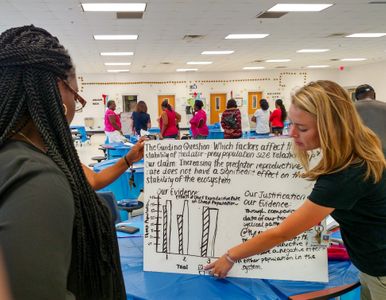- Name: D’Anna Muhammad
- District: Clayton Public Schools
- Role: K-12 Science Instructional Lead
How did you become interested in ADI?
I was first introduced to ADI as it was being introduced to Clayton County science teachers. I was a classroom teacher at the time, so I was part of the first cohort of teachers using ADI here in the district.
How is your district rolling out ADI?
We rolled it out with just secondary science teachers in that initial year (5 years ago). It was introduced during the summer and then we implemented it in August. Right around our second year, ADI teachers received side by side coaching. That gave us an opportunity to try it and then know what questions we had and then have support so that we knew exactly what to ask based on the real experience with students. During the second year, the expectation for the number of labs was increased to 8 ADI’s per year and that has been the expectation since then. We’re in our second year of implementation with ADI in elementary, and we used feedback from the secondary teachers to help us develop a plan on how to roll that out.
What has the impact been on student performance?
We’ve seen an increase in student performance, primarily on district benchmark assessments; as the assessment has changed to reflect our Georgia Science Standards of Excellence. The ADI’s have helped students to have gains on those assessments as a result of repetitive practice with the Science and Engineering Practices and the way they’re constantly using and connecting to the Crosscutting Concepts. Those experiences help students to be better able to tackle these newer kinds of questions.
We have noted that schools that have been continuing to use ADI with fidelity have seen continuing gains, where the schools that tried it and then sort of "slacked off" have gone backward on scores.
In Georgia, our tested grade levels are 5th, 8th, Biology, and Physical Science. This is our second year having ADI in elementary, so the teachers in 6th grade are noting that students are coming to them this year with that base knowledge about the stage of ADI that they can build on. Our 6th and 7th teachers don’t have state assessments, but they’re still using ADI so when these students get to 8th grade we’ll be monitoring to compare those that are in their 4th year of ADI versus those in previous years. Hopefully, we’ll continue to see that uptick as we’re continuing to use it across the district.
What challenges have you overcome, and how?
Our challenges have been being consistent with the use of ADI. We’re in the 5th year of use with secondary ADI, and when we go into classrooms we’re seeing teachers not using all 8 stages. They’re doing modified versions based on their own decision making. To help with this, we require 3rd grade through 12th-grade teachers to submit lab verifications a few times a year, which is their ADI written report. Teachers can choose any of the ADI’s completed during that window to submit. This helps us to make sure that it’s still being implemented, but more importantly, we can look at the student samples and have discussions around progress over the course of the year or the course of the semester. This allows us to get a feel for the types of additional support we need to provide at the district level.
Another challenge is that our high schools are in their first semester of semester block schedule so this change of more time but for a shorter period is a little bit overwhelming. Some teachers are not really sure how to implement the ADI so that they are pacing through the content effectively given the new structure of time. We’re working with them to see how to make that adjustment for block scheduling, get through the ADI, continue to hit those markers and provide that repetitive practice of skills.
What supports have you put in place for teachers?
For elementary we have purchased lab kits for teachers to use so that they aren’t having to pull resources together. They also have the guidance PowerPoints, the teacher guides, and the student handouts to support them through the process, and that has been very beneficial.
For secondary we didn’t purchase kits, they just purchase their resources based on the ADI’s they intend to do or the ADI’s that are in the curriculum framework. ADI is an expectation in science in our district, but in the past, we’ve had some teachers not necessarily have all the resources they need in secondary to do the ADI. This year their budgets were committed to ADI materials only, just to ensure that they have what they need.
For all levels, we’re continuing to provide side by side coaching and continued support to go back and monitor their use of ADI.
How have you made ADI fit in with your curriculum?
We have curriculum frameworks that we’ve provided for each content area and grade level to allow teachers to look at which ADI’s correlate with each unit. We also have a separate pacing document/scope and sequence so they can get an idea of what they need to cover in each unit and which ADI’s work within that unit. Teachers have flexibility on where in the unit to place the ADI’s, but the scope and sequence helps them make sure the year is structured in a way that makes sense. Our secondary courses work with that pretty well because their standards are a story and they’re teaching in an integrated way so it’s not isolated subject. Elementary is a little different, sometimes it works and all their standards go to together, and sometimes they skip a grade, but we at least try to help teachers see how each particular unit can be introduced as a story so they can figure out how to tie that ADI in with the other resources that are available in the district.
All of our units are driven by phenomenon. We see ADI as the foundational way that students will make sense of the phenomenon, with the other activities, labs, investigations, and informational texts being used to help create the rest of the story to help students fill in the gaps. Our goal is to help teachers figure out how to master the time they have along with all the resource options they have and we’re trying to focus on helping them see that as a process so that it’s not so overwhelming.
What advice do you have for other schools/districts thinking of rolling this out?
I would advise them to think carefully about their roll-out timeline. The way in which we did it was beneficial because it wasn’t overwhelming. Every school district in the world is analyzing where they are and what they need to keep and change, so change is a constant. This can, unfortunately, lead to teachers feeling overwhelmed. When you roll things out in manageable pieces it makes it easier for teachers to wrap their heads around it. In terms of resources I know that’s always a challenge as well. Rolling it out in pieces helps the district to be able to provide resources to support the introduction of ADI and then build on from there. This support helps make it where the teachers are more likely to buy-in to it and not just put it on the shelf.
We also used the idea of rolling this out over time as an opportunity to allow teachers to give their feedback to encourage others, and to have secondary teachers help us figure out a plan for our elementary roll out. Doing secondary first and then elementary allowed teachers to say to each other “This isn’t just something else, this is something good”.
You want to make sure you have a way to provide continued support. Continue to have side-by-side coaching and have individuals within the district become trainers. That has helped tremendously!




